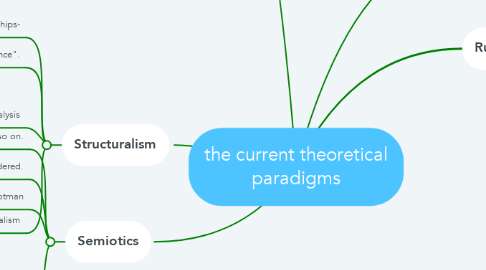
1. o Reception Theory
1.1. Wolfgang lser
1.1.1. reception theorists point out, there is no literature at all.
1.1.2. develop a new school of literary interpretation known as "reception theory".
1.2. . All the author can do is provide cues and hints as to what the reader should imagine
1.3. o This is determined by a variety of factors, including his understanding of literary conventions, personal experiences, and imagination.
1.4. . The Prague Structuralists come to be heavily influenced by semiotics, the study of signs.
1.5. The reader interprets a-text by
1.5.1. The reader makes implicit connections, fills in gaps, draws inferences and tests out hunches; and to do this means drawing on a tacit knowledge of the world in general and of literary conventions in particular.
1.5.2. o Iser imagined that the reading of literature was the catalyst of profound personal change.
2. Structuralism
2.1. . Structuralism, properly speaking, reduces a text to the relationships between its parts. The specific objects that occupy the parts in those relationships-
2.1.1. Like father and son
2.2. . The types of relationships can take many forms in different texts, ranging from "opposition" to "equivalence".
2.3. Structuralism literary analysis
2.3.1. Structuralist literary analysis was influenced heavily by the structuralist linguistic system of Ferdinand de Saussure.
2.3.2. . • a specific sign does not always have to be used to express a given signifier.
2.3.3. • Structuralist literary analysis is nothing more than an application of this to literature. structuralists ignore the content of stories in favor of the relationships between elements.
2.4. The Prague structuralism
2.4.1. structuralists ignore the content of stories in favor of the relationships between elements.
2.4.1.1. Signs are therefore "arbitrary". In other words, signs gain their meaning from their relationships and contrasts with other signs.
2.4.2. . The Prague Structuralists kept the same emphasis on the estranging nature of language.
2.4.3. Prague school emphasized the unity of the work and ignored anything considered external to it.
2.4.4. the Prague Structuralists understood the piece of literature not simply to be the text on the page, but rather a product both of the text itself
3. Semiotics
3.1. • The semiotician studies the relations between various signs, between signs and what they signify, and so on.
3.2. • his theory is also closely connected with reception theory, as he does not believe that the analysis of a poem is complete if only the poem itself is considered.
3.3. Yury Lotman
3.3.1. According to Lotman, a poem was a very dense collection of information that was conveyed through the words on the page,
3.3.1.1. Semiotics was developed in part by the Russian Yury Lotman, who especially worked on the application of semiotics to literature.
3.4. Mikhail Bakhtin
3.4.1. • According to Saussure, language was composed of signifiers and signifieds. The signifier
3.4.2. was one theorist who proposed these ideas.
3.4.3. He believed that true literary analysis involved not merely the study of signs, but also the study of the history of the signs and their uses by various social and economic groups.
3.4.3.1. • his theory is also closely connected with reception theory, as he does not believe that the analysis of a poem is complete if only the poem itself is considered.
3.4.4. • Bakhtin pointed out, a sign was often a battlefield among various groups in a society,
3.4.5. Therefore, language was the result of social and political conflict in society a
4. Phenomenology
4.1. German philosopher named Edmund Husserl created a new school of philosophy known as phenomenology,
4.2. Despite its emphasis upon the author's mind being present in the work,
4.3. This school saw works of kterature as images of the author's consciousnessand the work of the reader was to engage himself in the "world" that the text created
4.4. this mode of literary analysis is necessarily unevaluative
4.5. o This type of literary.criticism-and indeed phenomenology as a philosophy-rests upon a flawed understanding of language. o For phenomenological critics, language is simply a tool which the author transmits his consciousness}
5. Hermeneutics
5.1. E.D. Hirsch believed that the meaning of a text was something that existed in the author's mind before it was put in words.
5.2. Meaning is something that.is prior to and distinct from language
5.3. O (this understanding of literature is flawed in the same way that Husserl's understanding of language is. o It is impossible to separate meaning from language; it is impossible to "mean" something without putting that meaning into words.
5.4. The Hirsch’s literary theory
5.4.1. 1-The reader is explicitly forbidden to provide his own meaning to the text.
5.4.2. 3-His theory also assumes that absolute objectivity is possible. But objectivity is impossible
5.4.3. 2-He was very uncomfortable by the implication that the meaning of a text could change from one day to the next,
5.5. Hans-Georg Gadamer,
5.5.1. Heidegger, understood this last insight and incorporated it into the substance of his literary theory.
5.5.2. the meaning of a text extends beyond just the intentions of the author
5.6. o It is impossible for a reader to approach a text in a totally objective manner and the in itself
6. Russian formalism
6.1. Formalism is not itself exactly a structuralism
6.2. . Jakobson influence can be detected everywhere within formalism Czech structuralism and modern linguists.
6.3. -Jakobson was leader of the moscow linguistics circles.
6.4. . formalist group founded in 1915.
6.5. It is a literary school that developed around Jakobson.
6.5.1. The school incorporated Saussurean linguistics into the framework of Russian Formalism.
6.5.2. The Prague Structuralists kept the same emphasis on the estranging nature of language.
6.5.3. The value of literature,
6.5.4. Also like the Formalists, the Prague school emphasized the unity of the work and ignored anything considered external to it.
6.5.5. unlike the Formalists, the Prague Structuralists understood the piece of literature not simply to be the text on the page,
